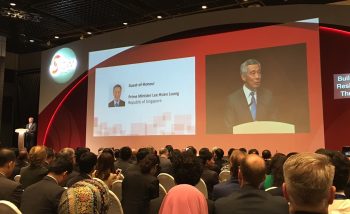Cyber securing an island republic: Singapore shows it means business
Singapore Prime Minister Lee Hsien Loong opened the inaugural SICW today, while also launching the nation’s cybersecurity strategy that comprises of four main pillars:
- Building resilient infrastructure
- Creating a safer cybersecurity
- Developing a vibrant cybersecurity ecosystem
- Strengthening international partnerships
Organised by CSA or the Cyber Security Agency of Singapore, which was formed only last year, the inaugural SICW would feature a week-long agenda of cybersecurity events for governments, businesses and even students from institutes of higher learning.
The CSA provides dedicated and centralised oversight of national cybersecurity functions and works with sector leads to protect Singapore’s critical services. This agency was established under the Prime Minister’s office and is managed by the Ministry of Communications and Information.
The strategy ultimately wants to combat cybercrime and enhance Singapore’s standing as a trusted data hub.
Some of the initiatives behind this goal include the National Cybercrime Action Plan launched by the Ministry of Home Affairs just last July.
Austere cybersecurity initiatives
In fact, IDA or the Infocomm Development Authority, before it was spun off to become Singapore’s Government Technology Organisation (GovTech), together with the MDA (Media Development Authority), aims to cut off Internet connectivity to public servants’ work computers by June next year.
PM Lee described it as Internet surfing separation whereby government employees can still surf the Internet to access news and information, but only on devices that are not connected to internal government networks.
Members of the cybersecurity industry have opined that a drastic measure like this may cause talent to shun employment in the Singapore public sector. One regional director said, “Internet network separation or air-gapping like this, is a method for the military. And it’s ok because freedom (in the military) is restricted anyway.
“This method may impede people from joining public service.”
Yet another regional director for an established software vendor said, “I have not heard of any cases of network separation being successful.”
Across borders
During his opening speech PM Lee also shared about strengthening Singapore’s partnership with ASEAN.
“With closer ASEAN integration, we are much more inter-connected that before.”
He also opined that ASEAN members should work more closely to promote consensus of cyber norms, strengthening operational linkages and building cyber capacity.
Even the Under Secretary General and High Representative for Disarmament Affairs for the United Nations (UNODA), Kim Won-soo was present at the opening ceremony of SICW 2016.
He shared his observation of the exponential growth of number of countries that are willing to engage in the use of ICT now. This indirectly increases cybersecurity risk as well.
He said, “The challenge for international community is how to collaborate easily. There is no easy solution and it’s important for global leaders to come together at forums like this to discuss the next steps (for global cybersecurity).”
Within ASEAN region itself, members have been working closely on many initiatives dealing with incident response, confidence building and technical cybercapacity building. Last August, Singapore and the United States had conducted a cybersecurity capacity building workshop for ASEAN countries.
Singapore also recently completed its 11th annual ASEAN CERT Incident Drill (ACID). This is to help CERTs (country emergency response team) test and improve cooperation and incident handling procedures. Further to this, Singapore will be announcing an ASEAN-level cyber capacity programme
(This journalist is a guest of Intel Security’s to this event in Singapore)
You must be logged in to post a comment.


There are no comments
Add yours